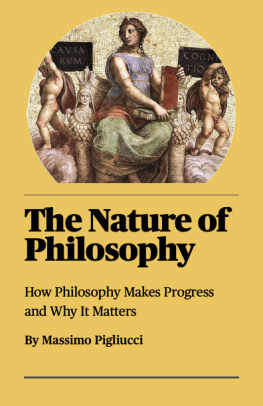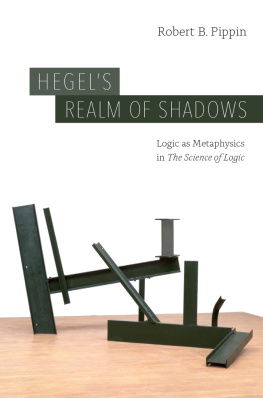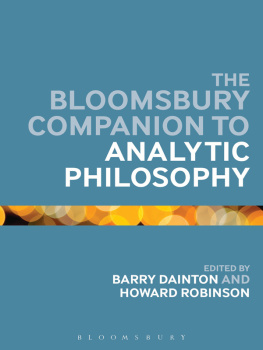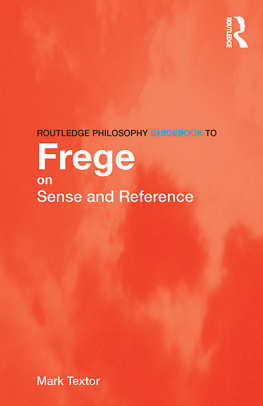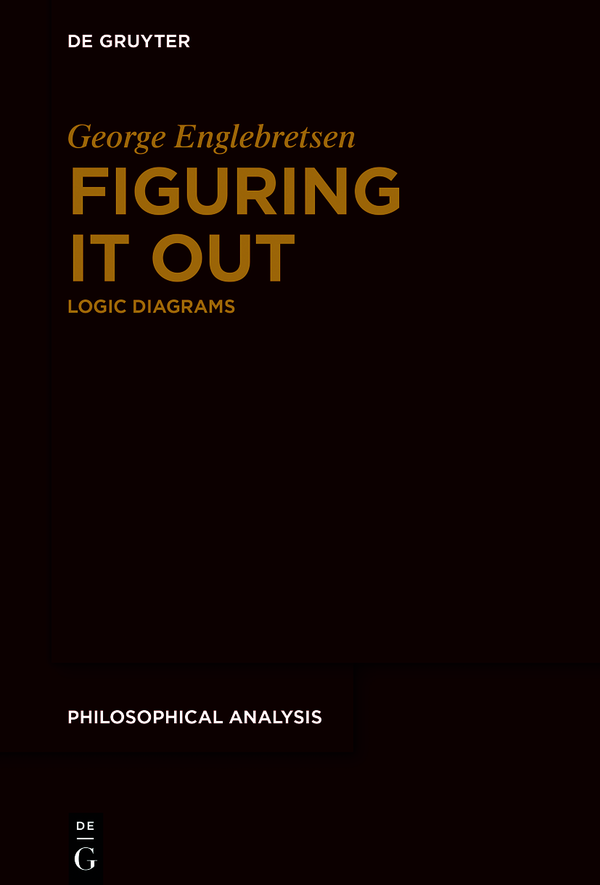George Englebretsen
Figuring It Out
Philosophical Analysis
Edited by
Katherine Dormandy
Rafael Hntelmann
Christian Kanzian
Uwe Meixner
Richard Schantz
Erwin Tegtmeier
Volume
George Englebretsen
Figuring It Out
Logic Diagrams
ISBN 9783110621631
e-ISBN (PDF) 9783110624458
e-ISBN (EPUB) 9783110621846
Bibliographic information published by the Deutsche Nationalbibliothek
The Deutsche Nationalbibliothek lists this publication in the Deutsche Nationalbibliografie; detailed bibliographic data are available on the Internet at http://dnb.dnb.de.
2019 Walter de Gruyter GmbH, Berlin/Boston
For:
Libbey, who draws the lines
Russell, who keeps the lines straight
Suzanne, who minds the intersections
Morgan, who directs the arrows
and Gal, who still draws the conclusion
(Emma, Carlee, Sam, Nathan, and Aaron continue to run in circles)
List of Figures
Figure 2.1:
The Pythagorean Theorem
Figure 2.2:
The Pentacle and the Golden Ratio
Figure 2.3: Figure 2.4:
The Diagonal of a Unit Square
Figure 2.5:
Aristotles First Square
Figure 2.6:
Aristotles Second Square
Figure 2.7:
Possible Line Diagrams for Barbara and Celarent
Figure 2.8:
Diagram of AB
Figure 2.9:
Diagrams for the Three Aristotelian Figures
Figure 2.10:
Diagram for Cesare
Figure 2.11:
Barbara and Baroco
Figure 2.12:
Leibnizs Linear Diagrams of the Categoricals (extensional)
Figure 2.13:
Leibnizian Diagram of Barbara
Figure 2.14:
Leibnizs Linear Diagrams of the Categoricals (intensional)
Figure 2.15:
Lambert Diagrams
Figure 2.16:
Euler Diagrams of the Categoricals
Figure 2.17:
Eulers Asterisk for Some S is P
Figure 2.18:
Euler Diagram for Cesare
Figure 2.19:
Euler Diagrams for Some A is not B and Some B is not A
Figure 2.20:
Euler Diagrams for Contradictory Pairs
Figure 2.21:
Euler Diagrams for All A are B and Some A are C
Figure 2.22:
Euler Diagrams for Contrary Pairs
Figure 2.23:
Venn Diagrams of Celarent and Festino
Figure 2.24:
Square Diagram for 4 Terms
Figure 2.25:
Peirces Diagram for Festino
Figure 2.26:
Pierce Diagram of Propositional Disjunction
Figure 2.27:
Alpha Graphs
Figure 2.28:
Beta Graphs for the Four Categoricals
Figure 2.29:
Beta Graphs with Relationals
Figure 2.30:
Beta Graphs of Identity
Figure 2.31:
Beta Graphs for Quantification
Figure 2.32:
Beta Graphs Illustrating Quantifier Scope
Figure 2.33:
A Single Beta Graph Illustrating a Logical Equivalence
Figure 2.34:
Fregean Diagrams for Propositional Logic
Figure 2.35:
Fregean Diagrams for Predicate Logic
Figure 2.36:
Fregean Diagram
Figure 2.37:
Fregean Modus Ponens
Figure 2.38:
Fregean Universal Instantiation
Figure 2.39:
A Fregean Proof
Figure 3.1:
Directed Graphs of A, E, I, and O
Figure 3.2:
Directed Graph of an Argument
Figure 3.3:
Directed Graph of Barbara
Figure 3.4:
Directed Graph of Celarent
Figure 3.5:
Directed Graph of Darii
Figure 3.6:
Directed Graph of Ferio
Figure 3.7:
SYLL Diagrams of the Four Perfect Syllogisms
Figure 3.8:
SYLL Diagram of Baramtip
Figure 3.9:
SYLL Proof that E and I are Contradictory
Figure 3.10:
A Term Line
Figure 3.11:
A Singular Term Point
Figure 3.12:
A Negative Term Line
Figure 3.13:
Universal Affirmative Line Diagram
Figure 3.14:
Line Diagram for Two Co-extensive Terms
Figure 3.15:
Universal Negative Line Diagram
Figure 3.16:
Particular Affirmative Line Diagram
Figure 3.17:
Diagrams for Predicate Denial and Term Negation
Figure 3.18:
Line Diagrams for Obverted Categoricals
Figure 3.19:
Line Diagrams for Affirmative and Negative Singulars
Figure 3.20:
An Attempted Diagram for a Contradictory Pair
Figure 3.21:
Diagrams for Tautologies
Figure 3.22:
Full Diagram of A
Figure 3.23:
Full Diagram of E
Figure 3.24:
Full Diagram of I
Figure 3.25:
Full Diagram of O
Figure 3.26:
Contrapictions of A/E Contrariety
Figure 3.27:
Diagram of Subcontrariety
Figure 3.28:
Two Versions of Subalternation
Figure 3.29:
Line Diagrams for the Perfect Syllogisms
Figure 3.30:
Line Diagrams for Universal and Particular Syllogisms
Figure 3.31:
Every M is P
Figure 3.32:
Barbara
Figure 3.33:
Cesare 1
Figure 3.34:
Cesare 2
Figure 3.35:
Datisi
Figure 3.36:
Bocardo
Figure 3.37:
Ferison
Figure 3.38:
Fresison
Figure 3.39:
Barbarip
Figure 3.40:
A Five-term Diagram
Figure 3.41:
An Inconsistent Set
Figure 3.42:
A Contrapiction of Baroco
Figure 3.43:
Wild Quantity
Figure 3.44:
Diagrams for Singular and Negative Singular Subjects
Figure 3.45:
Leibnizs Syllogism with a Singular Predicate Term
Figure 3.46:
Diagrammed Syllogism with Two Singular Terms
Figure 3.47:
Reflexivity, Symmetry, and Transitivity in TFL
Figure 3.48:
Diagrams With Terms of Explicit Denotation
Figure 3.49:
Diagrams With a Team Name and With an Explicit Team Name
Figure 3.50:
Romeo loves Juliet
Figure 3.51:
Juliet loves Romeo
Figure 3.52:
Unanalyzed Complex Relational
Figure 3.53:
Partially Analyzed Complex Relational
Figure 3.54:
Fully Analyzed Complex Relational
Figure 3.55:
The Principle of Relational Analysis
Figure 3.56:
A Corollary
Figure 3.57:
Unsimplified Relational
Figure 3.58:
Simplified Relational
Figure 3.59:
Valid Relational Inference
Figure 3.60:
De Morgans Inference
Figure 3.61:
Four Special Inferences
Figure 3.62:
The Principle of Relational Extension
Figure 3.63:
Specific vs Non-Specific Reference
Figure 3.64:
The Principle of Relational Reduction
Figure 3.65:
Attempted Singular Reflexive Diagram
Figure 3.66:
Singular Reflexive Diagram
Figure 3.67:
Attempted General Diagram
Figure 3.68:
Proper Diagram
Figure 3.69:
Argument With a Reflexive
Figure 3.70:
A Simple Pronominalization
Figure 3.71:
A Full Pronominalization
Figure 3.72:
An Example of Interlocking Pronominalizations
Figure 3.73:
A Diagrammed Inference with Pronouns
Figure 3.74:
Negative Relationals
Figure 3.75:
Inference with Negative and Positive Relationals
Figure 3.76:
How to Diagram a Singular
Figure 3.77:
Diagrams for Sentential Logic
Figure 3.78:
The Domain of Domains for Conditionals
Figure 3.79:
Alternative Diagrams for a Conjunctive Statement
Figure 3.80:
Diagrams for Contraposition
Figure 3.81:
Some Elementary Rules of Propositional Logic
Figure 3.82:
Unanalyzed and Analyzed Complex Terms
Figure 3.83:
A Diagrammed Deduction
Figure 3.84:
Diagram of a Consistent Set of Statements
Figure 3.85:
Proof of an Inconsistent Set of Statements
Figure 3.86:
Diagrammatic Resolutions of the Two Disanalogies
Figure 4.1:
Lemon and Pratt Counter-example
Figure 4.2:
Illustration of the Principle of Compound Term Analysis
Figure 4.3:
First Response to Lemon and Pratt
Figure 4.4:
Line Diagrams for a is a
Figure 4.5:
Beta Graphs for Something is a
Figure 4.6:
Second Response to Lemon and Pratt
Figure 4.7:
Beta Graph for A is greater than something greater than B
Figure 4.8:
ED Diagram for A is greater than something greater than B
Figure 4.9:
Beta Graph for A man gave a bribe to a senator



